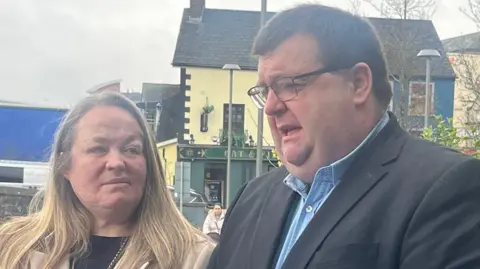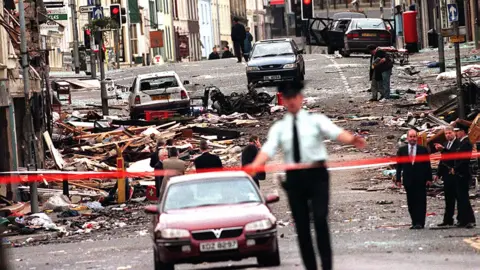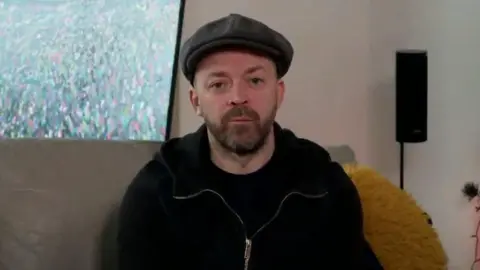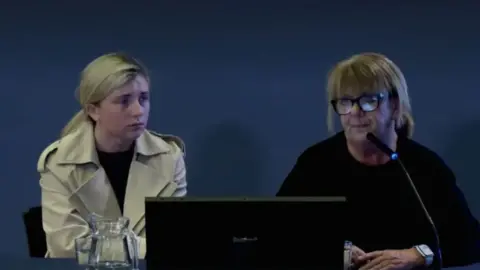Bomb survivor heard children shouting for their mums
 BBC
BBCWarning: This page contains distressing details
A man badly injured in the 1998 Omagh bomb has recalled rescuing his infant niece from the rubble of the explosion and then learning she had not survived.
Garry McGillion was on a shopping trip to buy 20-month-old Breda Devine shoes for his forthcoming wedding.
He told the public inquiry how he had handed Breda over to a policeman: "I felt her heartbeat on my chest. To this day, I still feel it."
When he found out she had died, he said, it was "something that ripped my heart out".
Mr McGillion was 24 at the time of the attack on on 15 August, which left him badly burned and with shrapnel injuries.
With his wedding due to take place a week later, he was in Omagh with his fiancee, his sister and Breda, his goddaughter.
The blast was like "an electric shock" to his body, he said.
"I could hear children shouting for their mums, mums shouting for their children, people shouting for loved ones, the piercing screams of people.
"The scenes I witnessed were horrendous. Those images will be forever ingrained in my brain.
"They have haunted me every day for the past 26 years."
 Pacemaker Press
Pacemaker PressMr McGillion and Donna-Marie McGillion were married a year later and now have two children.
He told the inquiry: "I know it wasn't my fault, but I was there to protect her [Breda].
"It's a guilt I will always carry.
"The scars are there forever, the hurt, the pain, the grief is there forever.
"We lost a beautiful girl that day.
"We can't bring her back but she lives on with us day and night."
At the conclusion of his evidence, inquiry chairman Lord Turnbull praised Mr McGillion's bravery in trying to save Breda.
Given last rites four times
Donna-Marie McGillion was 22 at the time of the attack.
She told the inquiry she was "forever grateful" to her husband for rescuing her and to the doctors who had saved her life.
Mrs McGillion was given a 20% chance of survival, after suffering burns to almost two thirds of her body.
She received the last rites on four occasions and shrapnel remains embedded in her neck and back.
"I am forever grateful, first of all to Garry, but also for anybody who did help me on the street that day, who got me to hospital, who worked with me in hospital, right through to all of my doctors and my surgeons," she said.
She told the inquiry she hoped it would obtain answers.
"We're never going to move on, it's always going to be there, but we need to have closure," she said.
Lord Turnbull said her evidence would help people understand the gravity of the attack.
 Omagh Bombing Inquiry
Omagh Bombing InquirySurvivor Jaime McGlinn said the force of the explosion had blown him out of his shoes.
He was 19 and, along with his girlfriend, had been evacuated from a coffee shop.
In video evidence played to the inquiry, he recalled the attack, which left him with a fractured skull and other injuries.
"The impact was unbelievable," he said.
"I remember landing on the ground. I remember the glass. I remember the smell.
"It was like burning matches.
"I remember coming round and being in the midst of devastation."
Mr McGlinn described himself as one of "the lucky ones".
He added: "I believe the inquiry is very important to close the chapter in a positive way for all of those involved that day."
'Didn't know where my daughter was for a week'
 Omagh Bombing Inquiry
Omagh Bombing InquiryCaroline McKinney owned a beauty salon in Omagh at the time of the bombing.
She said someone had come up and told the salon there was a bomb scare at the courthouse.
As she made her way down the street, Ms McKinney recalled "so many people, so many familiar faces" with everyone "chatting and in good form".
Then there was a "flash, there was a bang", Ms McKinney said, and she was aware the bomb had exploded in front of them.
She said the bomb had thrown her to the ground, and when she looked at the shop the shutter had come off, pinning her to the ground.
Ms McKinney added that the bomb had blown her daughter Niamh from her pram out into the street, and blood had been pouring down her face.
She knew her daughter was alive because she heard her crying, then a lady from the bakery took her away.
Ms McKinney did not know for a week where her daughter had gone, she recalled.
She explained that Niamh had been found in hospital thanks to the "little gold studs" in her ears, which indicated she was Caroline's daughter.
When she was discharged, Niamh started vomiting a black substance and was unsteady on her feet, and then an X-ray showed she had shrapnel in her head.
Medical professionals told her it was safer to leave the shrapnel in Niamh's head, but then epilepsy developed a few years later.
Ms McKinney said she had physiological and physical impact to this day.
'I was in a daze'
Survivor Katrine Gault sub-let a coffee shop on the corner of Market Street and Dublin Road at the time of the attack.
In a statement, read out to the inquiry, she said she had been walking towards the till when the bomb exploded.
It was so loud, she said, she "remembers sticking her fingers in her ears".
Ms Gault said she had tried to gather herself, knowing she had lots of injuries and was losing blood.
"I was in a daze. I don't know if I was knocked to the ground but I knew I had glass lodged all over my body," Ms Gault said
She said she did not know how long it was between the bomb exploding and when she made it out onto the street.
She recalled "water running down the road and it was stained with red blood".
'Not worried, as it was just a bomb scare'
In a statement read out to the inquiry, Caroline Taggart said she had been working at the bakery in Omagh at the time of the bombing.
She said she and her friends had not been worried by the bomb scare.
Her friend said she needed nail polish so they headed to the shop to buy it. When they were about 10 metres away from the car they spoke to her neighbour Avril Monaghan and her daughter.
Ms Taggart said she had spoken to her and. five seconds later, as soon as she had her foot at the door's entrance, the "bomb went off".
She said she remembered "the noise, the smoke, the screams, the glass, the flames" and thinking that "another bomb was going to go off".
She recalled getting up with "her clothes in ribbons, no shoes", and seeing many of her "work friends in the street, squealing and covered in blood".
Ms Taggart was taken to hospital where glass was removed from her foot.
She described the hospital as "absolute carnage".
Ms Taggart recalled meeting a woman who later died, along with her unborn twins, her mother and her daughter, adding: "I will never get these images out of my head. It's destroyed my life."
What was the Omagh bomb?
The bomb that devastated Omagh town centre in August 1998 was the biggest single atrocity in the history of the Troubles in Northern Ireland.
Twenty-nine people were killed, including nine children, a woman pregnant with twins, and three generations of one family.
It came less than three months after the people of Northern Ireland had voted yes to the Good Friday Agreement.
Who carried out the Omagh bombing?
Three days after the attack, the Real IRA released a statement claiming responsibility for the explosion.
It apologised to "civilian" victims and said its targets had been commercial.
Almost 27 years on, no-one has been convicted of carrying out the murders by a criminal court.
In 2009, a judge ruled that four men - Michael McKevitt, Liam Campbell, Colm Murphy and Seamus Daly - were all liable for the Omagh bomb.
The four men were ordered to pay a total of £1.6m in damages to the relatives, but appeals against the ruling delayed the compensation process.
A fifth man, Seamus McKenna, was acquitted in the civil action and died in a roofing accident in 2013.
The public inquiry
After years of campaigning by relatives, the public inquiry was set to up examine if the Real IRA attack could have been prevented by UK authorities.
This phase of the inquiry is continuing to hear powerful individual testimonies from relatives who lost loved ones in the explosion.
The bombers planned and launched the attack from the Republic of Ireland and the Irish government has promised to co-operate with the inquiry.
However, the victims' relatives wanted the Irish government to order its own separate public inquiry.
Dublin previously indicated there was no new evidence to merit such a move.
